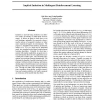215 search results - page 28 / 43 » Model-Based Reinforcement Learning with Continuous States an... |
ATAL
2007
Springer
14 years 1 months ago
2007
Springer
Temporal difference reinforcement learning algorithms are perfectly suited to autonomous agents because they learn directly from an agent’s experience based on sequential actio...
ICML
1999
IEEE
14 years 8 months ago
1999
IEEE
Imitation is actively being studied as an effective means of learning in multi-agent environments. It allows an agent to learn how to act well (perhaps optimally) by passively obs...
ECML
2003
Springer
14 years 23 days ago
2003
Springer
Abstract. Most of multi-agent reinforcement learning algorithms aim to converge to a Nash equilibrium, but a Nash equilibrium does not necessarily mean a desirable result. On the o...
ICCBR
2010
Springer
13 years 11 months ago
2010
Springer
In this paper we present an approach for reducing the memory footprint requirement of temporal difference methods in which the set of states is finite. We use case-based generaliza...
COST
2009
Springer
13 years 5 months ago
2009
Springer
Synchrony is claimed by psychology as a crucial parameter of any social interaction: to give to human a feeling of natural interaction, a feeling of agency [17], an agent must be a...

